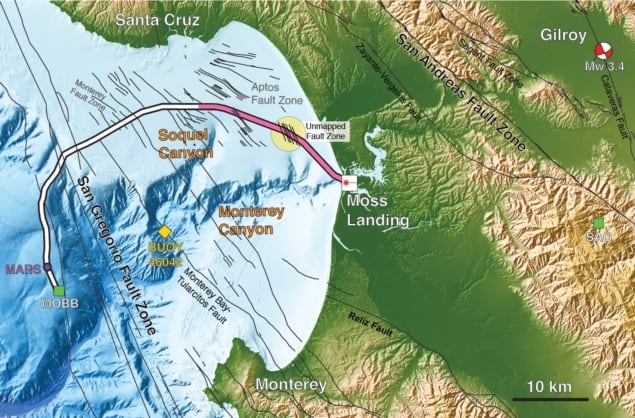
The expansive global network of undersea fibre-optic telecommunications cables could be used to measure offshore earthquakes and reveal geological structures beneath the ocean. That is the claim of researchers in the US, who demonstrated the concept by using a section of cable in California’s Monterey Bay to detect a small earthquake. They were also able to map out previously unknown geological faults and detect the seismic signals generated by ocean waves.
Around 70% of the Earth’s surface is covered by oceans and underwater seismic signals could provide information about offshore seismic hazards, underwater volcanoes, ocean movements and marine life. Today, however, our capacity to measure these signals is very limited and relies mainly on expensive and difficult-to-place monitoring stations on the ocean floor – which form a very patchy network.
“There is a huge need for sea floor seismology. Any instrumentation you get out into the ocean, even if is only for the first 50 km from shore, will be very useful,” says team member Nate Lindsay of the University of California, Berkeley.
In their new study, Lindsay and colleagues teamed up with Craig Dawe of the Monterey Bay Aquarium Research Institute, which owns a 51 km underwater fibre optic cable that was placed on the seabed in 2009 to link to the central node of a network of oceanographic sensors. At the time of the study, in the March of last year, the cable was offline for its annual maintenance, freeing it up for the team’s seismic experiment.
Distributed acoustic sensing
To convert the cable into a seismic measuring tool, the team used a technique known as distributed acoustic sensing. This involves sending short pulses of laser light through the cable. If the cable is stretched and deformed – even by a tiny amount – light is backscattered up the cable and picked up by a detector.
Using interferometric techniques, the researchers could measure the backscatter from individual 2 m sections of cable. In this way, the team used the first 20 km of the cable to create a sequence of 10,000 individual motion sensors that can monitor seismic activity and environmental noise in the ocean with an unprecedented resolution and scale.
“These systems are sensitive to changes of nanometres to hundreds of picometres for every metre of length,” says team member Jonathan Ajo-Franklin, who is based at Lawrence Berkeley National Laboratory. He adds, “That is a one-part-in-a-billion.”
Using the cable, the researchers recorded a broad range of seismic activity across four days in the Monterey Bay area – including a magnitude 3.4 earthquake with an epicentre 45 km inland. Ocean and storm waves, the measurements of which were shown to match recordings from buoys and land-based seismometers. The team were even able to use seismic scattering to map out the local San Gregorio Fault system and detect previously unknown faults within it.
“Frontier of seismology”
“This really is a study on the frontier of seismology, the first time anyone has used offshore fibre-optic cables for looking at these types of oceanographic signals or for imaging fault structures,” said Ajo-Franklin.
“This research shows the promise of using existing fibre-optic cables as arrays of sensors to image in new ways, said Berkeley geophysicist Michael Manga, who was not involved in the study. “Here, they’ve identified previously hypothesized waves that had not been detected before.”

Noisy freight trains could help predict California earthquakes
The approach will also be of great interest to volcanologists, notes Helmholtz Centre Potsdam geoscientist Philippe Jousset. “80% of volcanic activity occurs in the oceans,” he explains. “Because of inaccessibility, little is known about the characteristics of volcano structures and what they exude.”
According to Ajo-Franklin, the ultimate goal is to use the millions of kilometres of fibre-optic cables that weave their way across the world — both on land and underwater — to form a global seismic tracking network. This would be a low-cost way to extend our geophysical monitoring capacity not only to the oceans, but also to those regions on land that, unlike earthquake-prone California — do not have their own abundance of expensive seismic ground stations.
The team must first, however, show that their approach can be deployed on cables that are in use, rather than sitting dark like the Monterey cable. They will have to demonstrate that the laser pulses can travel through the cables without disrupting normal data transmission. The researchers are also doing further analysis of their Monterey Bay data and planning another test of the approach in a geothermally-active area south of California’s Salton Sea.
The research is described in Science.



